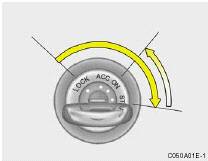 Hyundai Tucson: Starting
Hyundai Tucson: Starting
 Starting
Starting
WARNING: Never run the engine in a closed or poorly ventilated area any longer than is needed to move your car in or out of the area. The carbon monoxide gas emitted is odorless and can cause serious injury or death.
Normal Conditions:
The Starting Procedure: 1. Insert key, and fasten the seat belt. 2. Depress the clutch pedal fully and place the gearshift lever (manual transaxle) in neutral or the selector lever (automatic transaxle) in "P" (park) position. 3. After turning the ignition key to the "ON" position, make certain all warning lights and gauges are functioning properly before starting the engine.
WARNING: Be sure that the clutch is fully depressed when starting a manual transaxle vehicle. Your manual transaxle equipped vehicle will not start unless the clutch pedal is fully depressed.
4. Turn the ignition key to the "START" position and release it when the engine starts. After the engine has started, allow the engine to run for 10 to 20 seconds prior to placing the vehicle in gear. The starter should not be operated for more than 15 seconds at a time. Wait 15-30 seconds between starting attempts to protect the starter from overheating.
WARNING: Always fully depress the brake pedal before and while shifting out of the "P" Park position into another position to avoid inadvertent motion of the vehicle which could injure persons in or around the car.
 Key positions
Key positions
Key positions
CAUTION:
The engine should not be turned off or the
key removed from the ignition key cylinder
while the car is in motion. The steering
wheel is locked by removing the key.
...
 Operating the manual transaxle
Operating the manual transaxle
Your Hyundai's manual transaxle has a conventional
shift pattern. This shift pattern is imprinted
on the shift knob. The transaxle is fully
synchronized in all forward gears so shifting to
e ...
See also:
With CD mode selected
Press the “” button to skip
forward in the
track/file order. Press the “”
button to
skip backward in the track/file order. The
track/file number will be shown on the
audio display. ...
DOT, Tire Identification Number (TIN)
U.S. tire regulations prescribe that every manufacturer of new tires or retreader
has to imprint a TIN in or on the sidewall of each tire produced.
The TIN is a unique identification number. The ...
Winter tyres
In many countries legislation exists that
requires the use of winter tyres during
specified periods of the year.
M+S tyres have a recognised level of winter
performance and need not be replaced.
...
